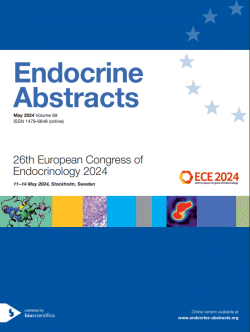
26th European Congress of Endocrinology
Stockholm,
Sweden
11 May 2024 - 14 May 2024

Poster Presentations
Environmental Endocrinology
ea0099p201 | Environmental Endocrinology | ECE2024
Systematic review of thyroid hormone patterns observed after exposure to endocrine disruptors in humans
Forner Isabel , Baig Asma , Kortenkamp Andreas
ea0099p202 | Environmental Endocrinology | ECE2024
Urinary iodine concentration and markers of thyroid activity in pregnant faroese women
Liggjasardottir Johannesen Herborg , Andersen Stig , Linding Andersen Stine , Skaalum Petersen Maria , Sofia Veyhe Anna
ea0099p203 | Environmental Endocrinology | ECE2024
Exploring a new avenue of disseminating peer-reviewed information on thyroid and PCOS conditions
Elhariry Maiar , Malhotra Kashish , Kempegowda Punith , Goyal Kashish
ea0099p204 | Environmental Endocrinology | ECE2024
The short-term effect of apparent temperature on the hydration marker plasma sodium
Franzen Anna , Pihlsgard Mats , Ekelund Ulf , Timpka Simon , Enhorning Sofia
ea0099p205 | Environmental Endocrinology | ECE2024
Real-life exposure to toxic metals: impact on thyroid gland function and male reproductive system in rats
Marić Đurđica , Baralić Katarina , Vukelić Dragana , Milošević Ivan , Nikolić Anja , Đukić-Ćosić Danijela , Bulat Zorica , Buha Aleksandra
ea0099p206 | Environmental Endocrinology | ECE2024
The influence of environmental and behavioral factors on male infertility associated hormones
Draganescu Daniela Dinu , Albulescu Adrian , Vladoiu Suzana , Alina Fudulu , Botezatu Anca , Adriana Ples , Iulia Virginia Iancu , Stancu Cristina , Muresan Andrei , Popa Oana-Monica , Udrea Luminita , Adina Rugescu Ioana , Draganescu Daria Dinu , Dumitrescu Ruxandra , Badiu Corin



